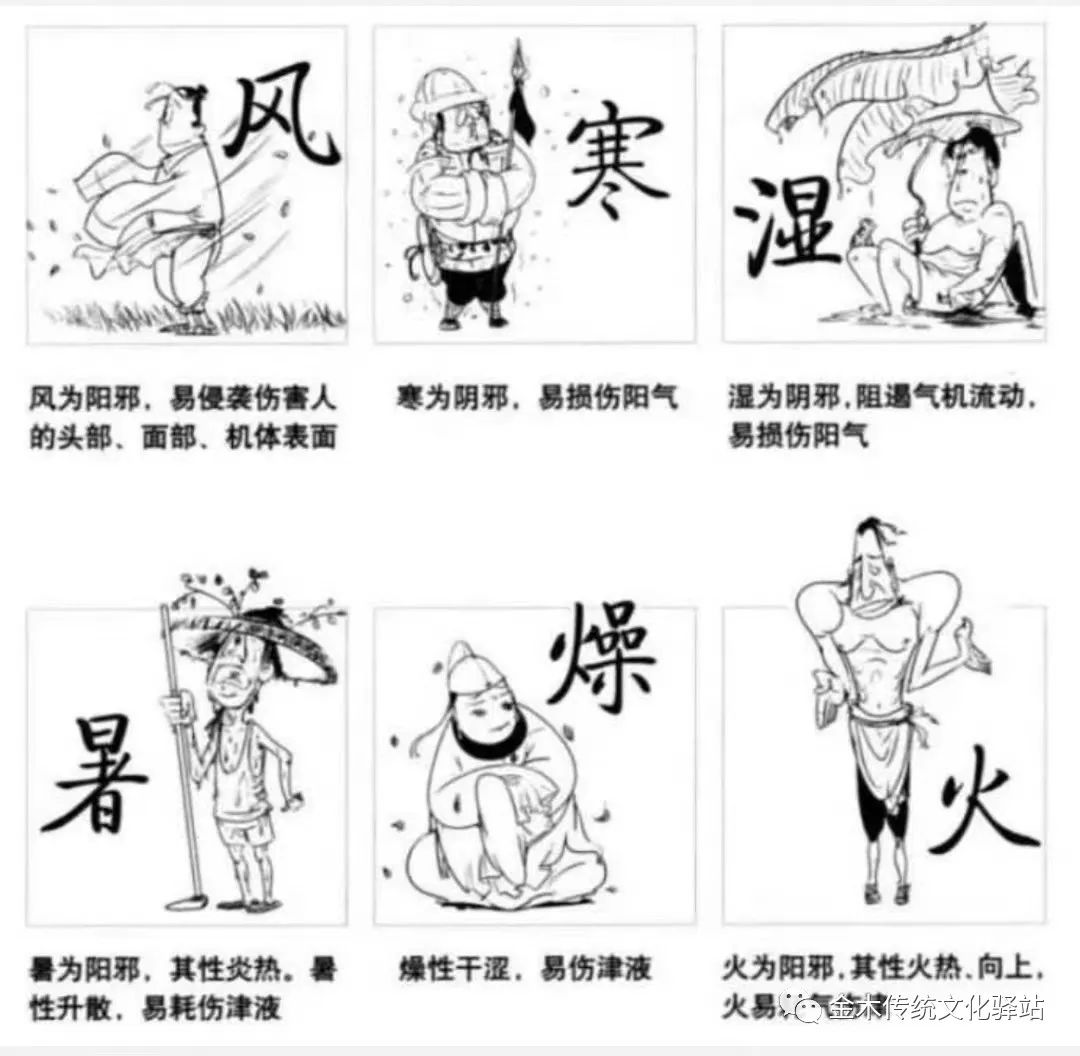The “Six Evils” (Liuyin) refer to the six types of pathogenic factors: Wind, Cold, Heat, Dampness, Dryness, and Fire. The differentiation of the Six Evils involves analyzing and summarizing various clinical data collected through the four diagnostic methods to determine whether the current pathological essence of the disease is related to the Six Evils.

The occurrence of diseases related to the Six Evils is often associated with seasonal climate and environmental conditions. For example, Wind diseases are more common in spring, Heat diseases in summer, Damp diseases in late summer, Dryness diseases in autumn, and Cold diseases in winter. Prolonged exposure to damp environments can lead to Damp diseases, while working in high-temperature conditions often results in Dry Heat diseases.Since the occurrence of diseases related to the Six Evils is due to the invasion of external pathogens, these diseases can exist independently, overlap with each other, or transform under certain conditions.

Here is a guide to differentiate the Six Evils and how to recognize them at a glance:Wind Evil Syndrome (Fengyin Zheng)Wind Evil Syndrome refers to the invasion of Wind pathogens affecting the skin and meridians, leading to dysfunction of the defensive Qi, presenting symptoms characteristic of “Wind”. This is often caused by sudden climate changes, unsuitable environments, or physical weakness. Wind is a Yang pathogen, characterized by its ability to disperse and invade Yang positions, often accompanied by other pathogenic factors. Therefore, Wind Evil Syndrome is characterized by rapid onset, quick changes, and erratic symptoms. Different locations of the disease can present different symptoms.Clinical manifestations: aversion to Wind and Cold, slight fever, sweating, floating and relaxed pulse, thin white tongue coating; may also include nasal congestion, clear nasal discharge, sneezing; or accompanied by throat itching and pain, coughing; or sudden skin itching and rashes; or sudden numbness of the skin, facial drooping; or joint pain that moves around; or sudden swelling of the face and limbs.Cold Evil Syndrome (Han Yin Zheng)Cold Evil Syndrome refers to the invasion of Cold pathogens, which restrain Yang Qi, primarily manifesting as aversion to Cold, absence of sweating, localized cold pain, and a tight pulse.This is often caused by exposure to rain, cold water, wearing insufficient clothing, sleeping outdoors, staying in extremely cold environments, or consuming raw and cold foods. Cold is a Yin pathogen, characterized by its ability to stagnate, constrict, and easily harm Yang Qi.Clinical manifestations: severe aversion to Cold, possibly accompanied by fever, absence of sweating, pain in the head and body, nasal congestion or clear nasal discharge, floating and tight pulse; may also present with cough, asthma, and expectoration of thin white phlegm; or abdominal pain, bowel sounds, diarrhea, vomiting; or coldness and stiffness in the limbs, localized cold pain, etc. No thirst, clear and long urine, pale or even bluish complexion, white tongue coating, tight or hidden pulse.Heat Evil Syndrome (Shu Yin Zheng)Heat Evil Syndrome refers to the invasion of Heat pathogens, which consume Qi and injure body fluids, primarily manifesting as fever, sweating, thirst, and fatigue.This is often caused by exposure to external Heat during the hot summer months. The pathogenic effects of Heat have strict seasonal characteristics. Heat is a Yang pathogen, characterized by its ability to disperse and consume Qi and fluids, and can easily combine with Dampness.Clinical manifestations: fever with aversion to heat, sweating, thirst with a preference for drinking, shortness of breath, fatigue, heaviness in the limbs, short yellow urine, red tongue, white or yellow tongue coating, weak and rapid pulse; may also present with sudden fainting, continuous sweating, shortness of breath, and even coma, convulsions, or seizures; or high fever, confusion, chest tightness, abdominal pain, nausea, and absence of sweating.Damp Evil Syndrome (Shu Yin Zheng)Damp Evil Syndrome refers to the invasion of external Dampness, which obstructs the body’s Qi and clear Yang, primarily manifesting as heaviness in the head and body, fatigue, and joint pain.This is often caused by humid climates, exposure to rain or water, or mist and dew. Damp Evil Syndrome is also known as external Dampness syndrome. Dampness is a Yin pathogen, characterized by its ability to obstruct Qi, harm Yang Qi, and create a sticky and heavy condition.Clinical manifestations: heavy head, drowsiness, body heaviness, chest tightness, poor appetite, nausea, joint and muscle pain, loose stools, cloudy urine. May also present with localized leakage of damp fluids, or skin rashes and itching, and women may experience increased vaginal discharge. Dull complexion, slippery and greasy tongue coating, and a soft or thin pulse.Dry Evil Syndrome (Zao Yin Zheng)Dry Evil Syndrome refers to the invasion of Dryness pathogens, which consume body fluids, primarily manifesting as dryness of the mouth, nose, throat, and skin.This is often caused by dry autumn weather or living in arid environments. The occurrence of Dry Evil Syndrome has clear seasonal or regional characteristics. Dryness is characterized by its ability to dry out, consume fluids, and easily harm the lungs.Clinical manifestations: dry skin, even cracking and flaking, dryness of the lips, nostrils, and throat, thirst, dry tongue coating, dry stools, or dry cough with little phlegm, difficult to expectorate, short yellow urine, and a floating pulse.In addition to the above clinical manifestations, cool dryness often presents with aversion to Cold and fever, absence of sweating, headache, floating and relaxed or tight pulse; warm dryness often presents with fever and sweating, throat pain, irritability, red tongue, and rapid pulse.Fire Evil Syndrome (Huo Yin Zheng)Fire Evil Syndrome refers to the invasion of Warm and Heat Fire pathogens, which lead to internal excess of Yang Heat, primarily manifesting as fever, thirst, flushed face, constipation, yellow urine, red tongue, yellow tongue coating, and rapid pulse.This is often caused by external invasion of Warm and Heat Fire pathogens or due to the accumulation of other external pathogens transforming into Heat. Fire, Heat, and Warm pathogens belong to the same category, differing only in intensity. Warm is a gradual form of Heat, while Fire is the extreme form of Heat, hence they are often referred to together. Fire, Heat, and Warm pathogens are Yang pathogens, characterized by their ability to scorch and consume fluids, harm Qi, and can lead to sores and ulcers.Clinical manifestations: fever with aversion to heat, irritability, thirst with a preference for drinking, profuse sweating, constipation, short yellow urine, flushed complexion, red or dark red tongue, yellow dry or gray-black tongue coating, and a rapid and strong pulse (such as flooding, rapid, or wiry pulse). In severe cases, may present with confusion, delirium, convulsions, vomiting blood, or bleeding..
Spreadknowledge of TCM health preservation, promote traditional Chinese culture,share health concepts, and convey care, passing health knowledge and traditional culture to more friends…
People are great because they have dreams; we are unique because we have love.
Liu Qing Ning: 186 9643 6785 or (WeChat ID)
Yang Shun Song: 138 7171 7447 or (WeChat ID)


